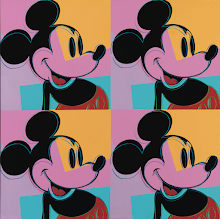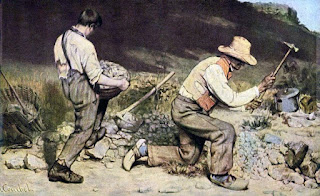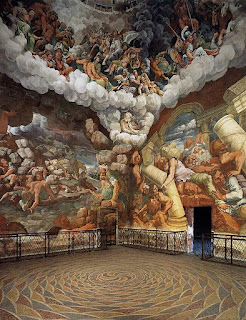Post Modern Era - The Influence of Celebrities/Pop Culture
What is Postmodern Art?
Postmodern art is an artistic genre that came from the late 19th century/20th century. During this era the focus shifted to incorporating different elements of mass media, pop culture, social hierarchy, etc. You also might find underlying issues like gender, race, class, and many more political, economic and social concerns of this century. The most common art forms would be through paintings and sculptures, but during this era photographs and cinematic videos became a popular source of digital art. The reason why postmodern art is heavily influenced by pop culture is because of the rise of social media/consumer culture. Through those elements many people identified themselves with what they were watching online on advertisements, television shows, and eventually social media would enter the picture. So for that reason artists felt that it was important to portray the effect of the media through their art. In my personal opinion I believe that these three artists do a great job of portraying postmodernism art. These people are Andy Warhol, Cindy Sherman, and Jeff Koons.
Andy Warhol
Andy Warhol is an American artist who is known to create many famous pop art pieces like his classic Campbell Soup Cans print as well as his Marilyn Monroe print, and many more. How Warhol created these prints was by using a technique called the silk screen printing which allowed him to duplicate his original artwork and from there he could elevate each individual frame Into different colors or volumes, really anything he desired. Warhol‘s work was typically known to have bright colors, and his use of repetition was pretty constant for every other painting he did. The two pieces of art that he chose from Warhol‘s collection are called Quadrant Mickey Mouse and Marilyn Monroe.
Andy Warhol created the Marilyn Monroe in 1967 where he established a print publishing business called Factory Additions. While he was there his artistic vision was to print duplicates of a photo that he took of Marilyn Monroe, and each duplicate would be a different color and it would go through a process of 1 to 5 printing screens in order to get the right color and wash of the print. From there he would edit little things that he did or didn’t prefer in order to perfect his piece. I find this image to be quite fascinating. It's like Warhol said, “The more you look at the same exact thing, the more meaning goes away, and the better and emptier you feel”. Honestly I totally agree with that statement because Marilyn Monroe is such an icon by looking at one photo you admire the person that she is, by making multiple photos of her and adding these different high volumized colors on the frame it makes it all just seem like art and isn’t putting so much significance on one person in one frame. This is when his use of repetition comes in his favor in order to get his meaning across. Would I own this painting? If I lived in a funky household with colors all over the place I totally would, but I wouldn’t necessarily say it’s my style. But I do respect a good piece of art.
This is another one of Andy Warhol‘s print paintings called Quadrant Mickey Mouse. It was created in 1981 and this print painting is very similar to the Marilyn Monroe print, but except for the various bright colors it’s the same painting and just in three other quadrants. During this era Mickey Mouse became one of the most popular cartoon characters at the time so it was very iconic of him to create this print masterpiece. His use of colors with orange, pink, blue in the classic Mickey Mouse colors all tied in very well. Plus the geometric shapes that offset Mickey Mouse makes it look so fun and creative just like the character itself. Just like I said for the Marilyn Monroe painting, I wouldn’t necessarily own this piece of art but I do have an aesthetic appreciation for the diversity of this painting at the time.
Cindy Sherman
Cindy Sherman is an American Artist known for photography. She is known for her theatrical self-portraits where typically she is portraying different characters that underlie themes of self identity, representation, and even gender. Shermans interest in photography started during college where she would take simple photos of herself and her friends and she would develop those pictures in a dark room, from there her interest of what she could do with photography grew. Once Sherman left College she knew that she wanted to do something great with photography. So she decided that she wanted to create a series of photographs which would eventually make her famous, and within these photographs she would call out different stereotypes and cultural assumptions about the woman's body, aging, and beauty.
This is one of Cindy Sherman‘s photographs that she took on her series called, Untitled Film Still #2. This photo was taken in 1977 and the premise of this photo was to portray a lonely housewife getting ready and admiring her beauty and body. All of her photos were taken in black-and-white to resemble a 1960s housewife sort of look because that was a stereotype during this time that men wanted their wives to be. I think this photo is so iconic because it does resemble a 1950s/60s Hollywood movie, and that it all is just so fictional/not realistic expectations of a woman. Personally, I don’t know if I would necessarily own this piece but I do admire her purpose of creating these film stills.
This here is another one of Cindy Sherman‘s films stills created in 1978 called, Untitled Film Still #8. In this photograph it looks like Cindy is standing off to the corner holding her plaid blanket or coat. I can't necessarily tell. The background looks like a desert, and she appears to look stranded. She is dressed like an ingénue in a portrayal of how Old Hollywood directors wanted women to presumably be. I enjoy Shermans photo stills each and every 70 of them! She does a fabulous job of portraying how women might feel that men are sexualizing or setting high standards for women to be like this character she is portraying through film. In every still she also looks very independent, which is another thing that I admire because also during the 1950s/60s men thought that women could be independent and that they required a man. Overall, I don’t think that I would own this piece of art but again, I do admire her purpose of creating this photo series.
Jeff Koons
Jeff Koons is an American artist that is known for creating polished fun sculptures of everyday objects. But most people famously know him for creating The famous stainless steel balloon animals like a giant balloon dog which I will discuss about later in his blog. Other than sculptures, Koons works and other forms of art like through painting, photography, and performance. Most of his work is in many famous museums like the New Museum of Contemporary Art in New York and the Museum of Contemporary Art in Chicago.
The first piece of art by Jeff Koons that we would look at is called, Balloon Dog. This is the most famous piece of art in his collection, this sculpture was sold for $58.4 millions dollars in 2013 that marked being the most expensive work being sold at an auction by a living artist ever. The reason why Koons creates balloon animals is because he believes that they resemble humans and we resemble them. He says, “We’re balloons. You take a breath and you inhale, it’s an optimism. You exhale, and it’s kind of a symbol of death.“. I think that’s an interesting correlation between humans and balloon animals. Taking an object that’s so different from humans and finding a common ground and creating art based on the common ground is something really fascinating about this artist. Overall, I would like to own this sculpture but preferably something a lot smaller. I admire how fun and lively it is, it reminds me of my childhood so I think it would be something fun to have on your nightstand or on your desk to admire.
“Andy Warhol. Marilyn Monroe. 1967: Moma.” The Museum of Modern Art, https://www.moma.org/collection/works/61240
“Andy Warhol. Quadrant Mickey Mouse.” Andy Warhol (1928-1987), https://www.christies.com/en/lot/lot-5896009
“Cindy Sherman. Untitled Film Still #8. 1978: Moma.” The Museum of Modern Art, https://www.moma.org/collection/works/56545?artist_id=5392&page=1&sov_referrer=artist
“Cindy Sherman. Untitled Film Still #2. 1977: Moma.” The Museum of Modern Art, https://www.moma.org/collection/works/56515?artist_id=5392&page=1&sov_referrer=artist
“Jeff Koons's Balloon Dogs - for Sale on Artsy.” Artsy, https://www.artsy.net/artist-series/jeff-koons-balloon-dogs
“Jeff Koons Balloon Flower.” Jeff Koons Balloon Flower | Modern Design by Moderndesign.org, http://www.moderndesign.org/2010/10/jeff-koons-balloon-flower.html








Hello Laney,
ReplyDeleteI think you did a fantastic job at connecting these pieces of art to your theme of how celebrities had an impact during the postmodern era. I originally wanted to talk about this topic so I'm glad that I came across your post and was able to see how someone explained this theme. Something that I want to point out that I found particularly interesting about your post is that your post could also be argued to show the diversity of art during this time. These artists all illustrate perfectly different materials and ways that they created art. I really love the section about Cindy Sherman, her pictures are very beautiful and I love the meaning that she is trying to display to those who look at the photos. Something I remember reading about her is that she believed her photos were best when they were looked at all at once because then the true message behind them became even more clear. I loved reading the background behind the other two artists as well and I actually talked about Jeff Koons in my own blog!
I absolutely love these pieces. My favorite are the steel balloon animals. They have a very playful nature to them and the bright colors have a lot of life. I also am a big fan of pop art. Pop art is a very different style from most things that I have looked at and I find it very refreshing. Out of all of these pieces I would love to own something similar to the Jeff Koon sculptures.
ReplyDeleteYour opinions on these works are incredibly well-put! I love how you chose three artists who were so different in style, but similar in their philosophies on life. Warhol's opinions on meaning being fleeting depending on how long you look at something, Sherman's works pointing out the meaninglessness of Hollywood's 'ideal woman', and Koons's sort of optimistic nihilism about the cycle of life and breathing relating to balloons all feel like they sort of interweave with one another. They seem, to me at least, to encourage one to be okay with meaninglessness, and feel free with the concept of aging and death, as these are natural parts of life and experience.
ReplyDelete